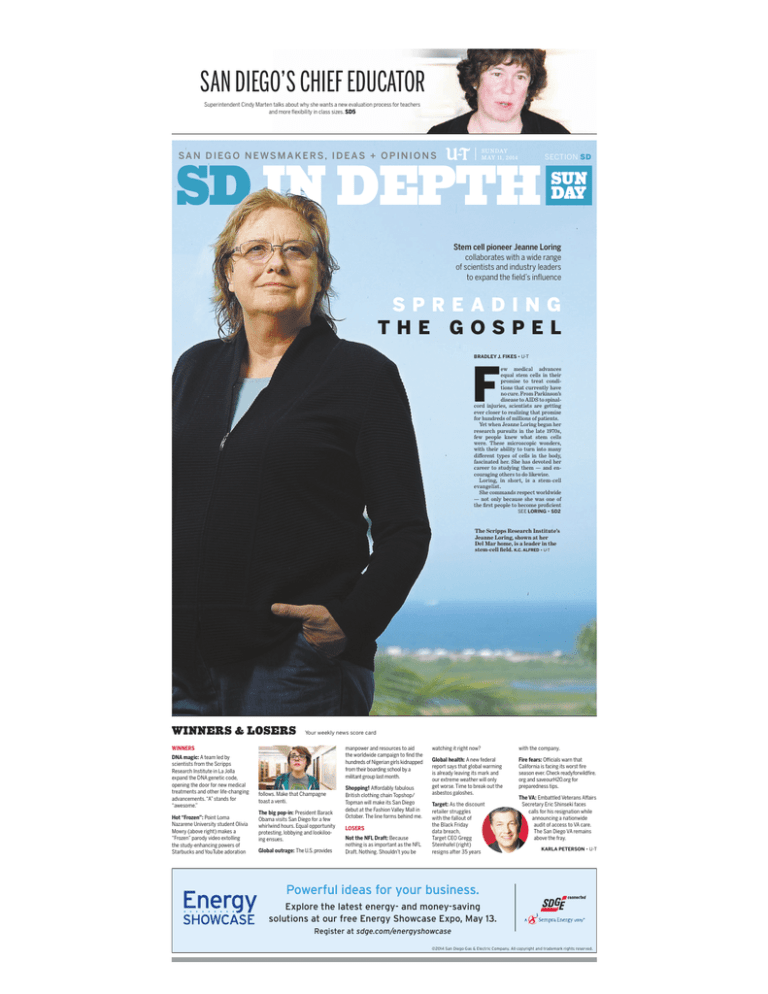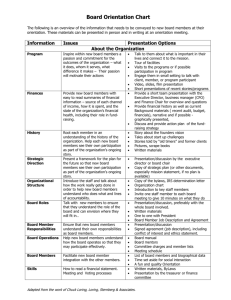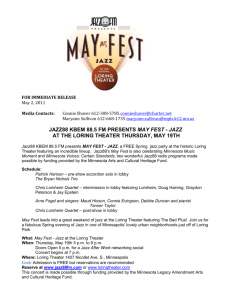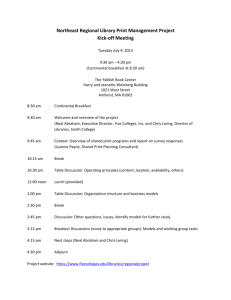
SAN DIEGO’S CHIEF EDUCATOR
Superintendent Cindy Marten talks about why she wants a new evaluation process for teachers
and more flexibility in class sizes. SD5
SUNDAY
MAY 11, 2014
SAN DIEGO NEWSMAKERS, IDEAS + OPINIONS
SD IN DEPTH
SECTION SD
SUN
DAY
Stem cell pioneer Jeanne Loring
collaborates with a wide range
of scientists and industry leaders
to expand the field’s influence
SPREADING
THE GOSPEL
BRADLEY J. FIKES • U-T
F
ew medical advances
equal stem cells in their
promise to treat conditions that currently have
no cure. From Parkinson’s
disease to AIDS to spinalcord injuries, scientists are getting
ever closer to realizing that promise
for hundreds of millions of patients.
Yet when Jeanne Loring began her
research pursuits in the late 1970s,
few people knew what stem cells
were. These microscopic wonders,
with their ability to turn into many
different types of cells in the body,
fascinated her. She has devoted her
career to studying them — and encouraging others to do likewise.
Loring, in short, is a stem-cell
evangelist.
She commands respect worldwide
— not only because she was one of
the first people to become proficient
SEE LORING • SD2
The Scripps Research Institute’s
Jeanne Loring, shown at her
Del Mar home, is a leader in the
stem-cell field. K.C. ALFRED • U-T
WINNERS & LOSERS
Your weekly news score card
manpower and resources to aid
the worldwide campaign to find the
hundreds of Nigerian girls kidnapped
from their boarding school by a
militant group last month.
WINNERS
DNA magic: A team led by
scientists from the Scripps
Research Institute in La Jolla
expand the DNA genetic code,
opening the door for new medical
treatments and other life-changing
advancements. “A” stands for
“awesome.”
Hot “Frozen”: Point Loma
Nazarene University student Olivia
Mowry (above right) makes a
“Frozen” parody video extolling
the study-enhancing powers of
Starbucks and YouTube adoration
follows. Make that Champagne
toast a venti.
The big pop-in: President Barack
Obama visits San Diego for a few
whirlwind hours. Equal opportunity
protesting, lobbying and lookilooing ensues.
Global outrage: The U.S. provides
Shopping! Affordably fabulous
British clothing chain Topshop/
Topman will make its San Diego
debut at the Fashion Valley Mall in
October. The line forms behind me.
LOSERS
Not the NFL Draft: Because
nothing is as important as the NFL
Draft. Nothing. Shouldn’t you be
watching it right now?
with the company.
Global health: A new federal
report says that global warming
is already leaving its mark and
our extreme weather will only
get worse. Time to break out the
asbestos galoshes.
Fire fears: Officials warn that
California is facing its worst fire
season ever. Check readyforwildfire.
org and saveourH20.org for
preparedness tips.
Target: As the discount
retailer struggles
with the fallout of
the Black Friday
data breach,
Target CEO Gregg
Steinhafel (right)
resigns after 35 years
The VA: Embattled Veterans Affairs
Secretary Eric Shinseki faces
calls for his resignation while
announcing a nationwide
audit of access to VA care.
The San Diego VA remains
above the fray.
KARLA PETERSON • U-T
Powerful ideas for your business.
Explore the latest energy- and money-saving
solutions at our free Energy Showcase Expo, May 13.
Register at sdge.com/energyshowcase
©2014 San Diego Gas & Electric Company. All copyright and trademark rights reserved.
SD3
U-T SAN DIEGO | SUNDAY • MAY 11, 2014
LORING
Scientist knew
she wanted to
work in a field
with constant
collaboration
Jeanne Loring
holds a petri dish
with pluripotent
stem cells from
a Parkinson’s
patient.
HOWARD LIPIN • U-T
FROM SD1
in producing human embryonic
stem cells in the lab, but also because her collaborative spirit has
been foundational in expanding
the stem-cell field to new generations of scientists.
At the request of the National
Institutes of Health, she co-wrote
a manual on the subject to train
other researchers. She also provided knowledge that was crucial
in courtroom battles against a
patent that had put a stranglehold on stem cell studies nationwide. And she helped establish a
trailblazing training program for
stem-cell scientists in Southern
California.
Today, as a leading figure at
The Scripps Research Institute
in La Jolla, Loring is widely considered both a stem-cell pioneer
and a key voice on the latest issues in the field.
She’s a board member of the
institute that funds and coordinates much of the stem-cell research in California. She revels in
teamwork with experts at other
scholarly institutions, in industry and from patient-advocacy
groups. And she’s internationally
renowned for her findings on how
stem cells might treat neurological diseases.
But Loring is happy to be more
of a behind-the-scenes player.
“Sometimes you hear about
scientists who are pie-in-the-sky
crazy people, and you’ve got to
lasso them back down to Earth.
That’s not a problem with Jeanne.
She’s got her feet planted firmly
on the Earth,” said Daniel Ravicher, an attorney with the Santa
Monica-based group Consumer
Watchdog and founder of the
Public Patent Foundation.
Loring said she values the
dynamics of experts working
together. It’s a conspicuous contrast to the largely solitary career
of her geologist father, who did
much of his prospecting alone in
the deserts of Western states.
“I could not see myself doing
that,” Loring said. “It was too
lonely. The biological sciences require you to talk to people a lot.”
Unlike the “pure” academic
who regards partnerships with
businesses as compromising science, Loring said ties with industry can be rewarding. Businesses
can take basic research discoveries and turn them into drugs and
other therapies, she said, and
that “translational” arrangement
is hard to replicate in a walled-off
academic setting.
While working for biotechs
in the San Francisco Bay Area
relatively early in her career,
Loring developed a patented
“Sometimes you hear about scientists who are pie-in-thesky crazy people, and you’ve got to lasso them back down
to Earth. That’s not a problem with Jeanne. She’s got her
feet planted firmly on the Earth.” Daniel Ravicher • attorney with Consumer Watchdog
mouse model of Alzheimer’s
disease and a patented method
for determining the amount of
plaque in brain cells taken from
deceased Alzheimer’s patients.
She also helped a company test
fetal brain cells as a potential
therapy for Parkinson’s disease;
the technique failed because the
technology was too primitive.
Loring’s work now mainly concerns artificial embryonic stem
cells, called induced pluripotent
stem cells. Grown from skin, they
don’t raise the thorny ethical issues linked to embryonic stem
cells and can be custom-made
for individuals.
Public duty
Loring frequently speaks out
on issues concerning science.
As the recipient of government
grants, she said she has an obligation to keep the public informed
and make the best use of taxpayer
money.
In 2006, Loring joined a legal
challenge to some patents held by
the Wisconsin Alumni Research
Foundation, or WARF, on deriving human embryonic stem cells.
The patents unfairly prevented
many scientists from engaging
in the field, she said.
The litigation, led by the nonprofit Consumer Watchdog, has
largely succeeded in reducing the
patents’ scope.
Loring provided scientific expertise deemed pivotal in rebutting WARF’s assertions, said
attorney Ravicher. For example,
she undermined the foundation’s
legal claim that its derivation
method wasn’t “obvious.”
The WARF patents covered
a method of making human embryonic stem cells that was previously used on various animals.
The foundation reasoned that
applying the method to human
embryos wasn’t obvious because
human embryos are different
from animal embryos.
“(Loring) was the one who came
up with the argument that while
all these embryos are indeed
different from human embryos,
they’re all different from each
other as well,” Ravicher said.
Over the years, Loring also has
warned her stem-cell colleagues
that they can lose the public’s
trust because of repeated examples of fraudulent or shoddy
science.
Earlier this year, Japanese and
American scientists published research on how to produce stem
cells through simple methods
such as dipping cells in an acid
bath. The research was later
found to contain grave errors that
made it invalid.
Loring was interviewed by a
Japanese journalist about the debacle surrounding these so-called
“STAP” cells.
“He asked me, ‘Could that happen in your lab?’ I said no, because
(our scientists) all work together.
They’d have to conspire,” she said.
“The structure of the way you do
science can encourage dishonesty, and you can discourage it by
structuring it differently.”
Loring’s latest pursuits
Not only for nerds
Loring was born in 1950 in
Tucson, Ariz., to William and
Elizabeth “Liz” Loring. She has a
sister, Anne.
The family periodically moved
across the far West as her father
prospected for uranium with a
Geiger counter in desert after
desert. Loring credits him with
providing an education that was
impossible to get at the small
towns where she went to school.
“My father was a real intellectual. He wrote poetry and he
read all the classics, and he’d often read them to me,” she said.
“He expected my sister and I to
be articulate. He expected us to
appreciate literature. I almost felt
like I was home-schooled. I went
to schools where I knew more
than the teachers did.”
In 1967, Loring’s unofficial education and her own studies paid
• In mouse models of multiple
sclerosis, therapy with neural stem
cells restored movement, something Loring wants to try in people.
Surprisingly, the treated mice improved although the transplanted
cells all died.
SEE LORING • SD8
Jeanne Loring’s current projects
include:
• Eight San Diego-area Parkinson’s
patients are expected to receive an
IPS cell treatment Loring helped
develop. Brain cells grown from the
patient’s own IPS cells are to be
transplanted into their brains next
year, if federal regulators approve.
• Stem cells from endangered species such as the white rhino (above)
have been created by Loring and her
lab with the help of the San Diego
Zoo. This frozen collection of cells
may one day allow the resurrection
of species verging on extinction or
perhaps already extinct.
TREATMENTS REACHING PATIENTS
Hundreds of clinical trials using stem or regenerative cells are taking place in California and around the world
BRADLEY J. FIKES • U-T
A
fter many years of waiting, a flood of new regenerative-cell therapies
is finally reaching patients. Hundreds of clinical trials
for these experimental treatments
are under way across the world.
In the United States, 774 trials
with stem or other regenerative
cells are open to patients or soon
will be, according to clinicaltrials.gov, which lists governmentapproved clinical testing in this
country and abroad. Of that total,
147 are taking place in California.
One of the most difficult tests involving stem cells — repairing spinal-cord damage that has caused
complete loss of movement and
sensation below the injury site
— is set to begin soon at UC San
Diego.
Patients in that study will get
injections of fetal-derived neural
stem cells in and around the injury
site, along with physical therapy
and immune-system drugs in case
there’s a reaction to the stem cells.
The trial will use a device that delivers precisely targeted “microinjections” of cells to the targeted
areas.
The clinical trial will test safety
and look for early signs of efficacy,
said Dr. Joseph Ciacci, a UC San
Diego neurosurgeon leading the
testing.
A study published a year ago
found that in rats with spinal-cord
injuries, the neural stem cells significantly improved movement in the
hind paws. Ciacci, who co-authored
that study, saw the cells proliferate
and fill in a spinal-cord cavity that
UC San Diego neurosurgeon Dr. Joseph Ciacci will be leading a clinical trial involving
stem cells to treat paralysis from spinal-cord injury. HOWARD LIPIN • U-T
had resulted from the injuries.
Such results supported testing
the therapy in people, he said, but
he declined to say whether he expected to see any improvement in
those patients.
“I really don’t know, because it’s
not been done,” Ciacci said.
The clinical trial is expected
to start in June. It’s intended for
adults 18 to 65 years old who suffered their injury at least one year
ago but no more than two years
ago. For more information, visit
utsandiego.com/ucsdspinal or call
Amber Faulise at (858) 657-5175.
Another type of stem cells,
mesenchymal stromal, might
be described as the duct tape of
regenerative cells. Generally derived from bone marrow, they
are being tested for treatment
of pulmonary fibrosis, multiple
sclerosis, kidney transplants,
liver cirrhosis, osteoarthritis of
the knee, stroke and many other
conditions. Worldwide, 226 trials
are being conducted with these
cells, including 45 in the U.S. and
12 in California, according to clinicaltrials.gov.
These cells function as “natural
immune regulators,” said Jacques
Galipeau, a professor of hematology and medical oncology at the
Winship Cancer Institute at Emory University in Atlanta. Galipeau
is leading a study on using these
cells to treat Crohn’s disease, an
inflammatory autoimmune disorder of the bowels. Information on
his test can be found by searching for “Galipeau” at clinicaltrials.
gov.
Mesenchymal stromal are babysitters for blood-forming stem cells,
guiding their development, Galipeau said. They also act as traffic cops
for immune-system cells and help
in repairing injuries.
“Mesenchymal stromal cells
seem to be able to mobilize from
bone marrow and other tissues in
which they nest — fat, for example
— and participate in the repair response,” Galipeau said. “And a big
part of what they do is to regulate
inflammation.”
While Ciacci’s trial uses stem
cells taken from other people,
Galipeau is using each patient’s
own mesenchymal cells that were
multiplied in the laboratory and
infused back into that person.
Nothing needs to be done to
the cells — “no genetic engineering, nothing spooky,” Galipeau
said. “The natural property they
possess is that they hose down
inflammation.”
The anti-inflammatory property of these cells makes them suitable for treating a wide range of
immune diseases, Galipeau said.
Larry Goldstein, head of stem
cell research at UC San Diego,
said stem-cell treatments are
reaching clinical trials “pretty
speedily,” considering how much
basic research had to be done to
get the technology ready.
“Brain injury, spinal-cord injury, neurodegenerative disease,
drug development — it’s really a
terrific broad portfolio of things
that are moving into the clinic,”
Goldstein said. “The thing that
makes me most unhappy is, as a
consumer, I desperately want everything to be ready to apply to
patients successfully tomorrow,
not in years. But we’ve got to do it
by the book so that we don’t hurt
anybody, and we have to do it in a
way that’s efficacious.
“But I’m always frustrated at the
rate of progress. If you have a sick
family member or you yourself are
sick, it’s never fast enough.”
bradley.fikes@utsandiego.com
(619) 293-1020
Twitter: @sandiegoscience
SD8
U-T SAN DIEGO | SUNDAY • MAY 11, 2014
LORING • She has long been driven to apply knowledge to practical uses
FROM SD3
off when she won a National Merit Scholarship. The
money allowed her to attend
the University of Washington in Seattle, where she
earned a bachelor’s degree
in molecular biology.
Loring had started out as
an English major and added
science classes as a secondary interest.
“I was good at science, but I
thought it was only for nerds,”
Loring said.
She soon changed her
mind. “I found I was doing
a lot better in the science
classes than I was in the literature classes, and I was
enjoying them more.”
Loring described herself
as discreetly “ultra-competitive” during her university days. While working to
land top grades on tests, she
avoided calling attention to
herself for fear of offending
male egos.
“I got the highest score in
my biochemistry class, and
the professor announced that
in class. I refused to go up
there, because I didn’t want
anyone paying attention to
me,” she recalled. “I didn’t
want the pressure — ‘Oh my
God, a girl beat me.’ I didn’t
want to evoke that.”
Loring continued her
schooling with graduate
studies at the University of
Oregon in Eugene, where she
ran into trouble: Her adviser
wanted her to work on her
own, not collaborate with
others.
“It seems absurd in retrospect, but his style was, ‘You
do your own project.’ You
could talk with other people
but you couldn’t work with
them. He kept getting angry
with me for that,” Loring remembered.
In another development,
Loring met her future husband, David Barker, at the
same university. He was a
professor there, and they
were both married at the
time.
“It was quite a scandal,”
she said.
(Barker’s own career is
notable; he was once the
chief scientific officer for
stem-cell scientist, jokingly
said he saved Loring from
the “dark side” — industry
— by recruiting her.
Together, they launched
what may have been the
first stem-cell “core facility”
in Southern California and
the region’s first training
program for stem-cell researchers, Snyder said.
Even after Loring moved
to The Scripps Research
Institute in 2007, she maintained her professional endeavors with Snyder.
“We were always co-workers and collaborators,” Snyder said. “In fact, she has
an adjunct appointment at
Sanford-Burnham. She stays
completely involved, and I’ve
stayed actively involved with
the Scripps program.”
Astronomy is among the interests Jeanne Loring pursues in her scant free time. The Scripps Research Institute researcher and her husband try to take an annual solar eclipse vacation. K.C. ALFRED • U-T
the DNA sequencing giant
Illumina, which is headquartered in San Diego.)
Loring eventually obtained a doctorate in developmental neurobiology at
the University of Oregon.
It was a direct precursor to
her work with embryonic
stem cells.
“I studied neural crest
stem cells. There were
no embryonic stem cells
(known to scientists) then;
those were not made (in the
lab) until the early 1980s,”
she said. “My thesis was
— in a very primitive way
— how neural crest cells
made the decision to be a
neuron or pigment cell, and
how I could influence them
by culturing them differently. The concept of having
a cell that could do multiple
things interested me.”
Academia and biotech
Loring began her professional career as a temporary assistant professor at
UC Davis in 1982. She left
five years later, concluding
that she would never get a
tenure-track position there.
She was also eager to begin
putting her research knowledge to more practical uses.
That opportunity came in
1987, when she was hired as a
senior staff scientist at Hana
BiologicsinAlameda.Among
its projects, the biotech company was developing a treatment for Parkinson’s disease
using cells grown from fetal
brains.
“It’s a completely different world than in academia,”
Loring said. “We’re talking
about clinical trials ... and
I learned from them that it
was possible to go from a lab
experiment into a clinical
trial.”
But the envisioned treatment didn’t work, and Hana
Biologics went under.
Loring kept adding to her
skills with each new job.
At the next workplace,
GenPharm in the Bay Area,
Loring designed the mouse
model of Alzheimer’s disease.
She and colleagues became
skilled at writing applications
for federal grants, mainly for
stem-cell research.
“It was the richest scientific environment I was ever
in, and it was the most collaborative,” Loring remembered.
GenPharm failed in 1995
after a lawsuit derailed plans
for it to hold a public offering.
Loring was more fortunate:
She had four years left on a
Small Business Innovation
Grant for making rat embryonic stem cells, and it
was transferable to another
company.
“I learned that if you have
your own money, you have
lots more choices,” Loring
said.
Access battle
During the late 1990s, she
decided it was time to move
from rat embryonic stem
cells to the human kind. She
founded a company to do so
— Arcos Biosciences in San
Mateo.
Producing human embryonic stem cells was much
more difficult because the
embryos and government
funding for such research
were harder to obtain at the
time.
It became even more difficult when the Wisconsin
“I’ve spent over 40 years
working to keep the power on.”
connected ••••• to reliable energy
Rick is one of SDG&E’s troubleshooters. He’s on the road responding to electric outages and
trouble spots, working to restore power as safely and quickly as possible. It’s people like Rick
that make SDG&E one of the most reliable utilities in the United States. Meet him in a new
online video series, “SDG&me.”
Connect with Rick’s story at sdge.com/me.
©2014 San Diego Gas & Electric Company. Trademarks are the property of their respective owners. All rights reserved.
Alumni Research Foundation received patents for
creating human embryonic
stem cells. University of
Wisconsin scientist Jamie
Thomson became famous
for isolating those long-elusive cells in 1998.
The WARF patents frightened off investors for various
stem-cell ventures, Loring
said, and Arcos folded.
By then, Loring had derived nine lines of human
embryonic stem cells, which
were among the lines President George W. Bush approved for federal funding
in August 2001. They were
subsequently acquired from
Arcos by CyThera, a San Diego-based biotech firm.
That company, since renamed as ViaCyte, is preparing to start human clinical trials of a treatment for
Type 1 diabetes, using insulin-producing cells derived
from embryonic stem cells.
Loring moved to San Diego in 2003, when she returned to academia by joining the Sanford-Burnham
Medical Research Institute.
Evan Snyder, a prominent
Away from science
With so much to do, it’s
hard for Loring to find leisure time. There’s always
some task in the lab. And
even when Loring travels, it’s
almost always work-related.
“I go to a conference probably every month,” she said.
“It’s not a break from work,
it’s working someplace else.
Part of our jobs is to tell
people about our work, and
you have to go somewhere
to do it.”
But Loring and her husband give themselves one
respite a year: They take a
solar eclipse vacation.
“The eclipse vacations
are the perfect thing for us,”
Loring said. “You can always
work, but the eclipse is going to happen at a certain
time and a certain place,
and you have to be there
when it happens. Almost every year, there is an eclipse
somewhere exotic — Bolivia,
Zambia. We went to Libya.”
A decade ago, when there
was no solar eclipse to view,
Loring and Barker took a
vacation to Australia for
another purpose: After
many years together, they
got married.
bradley.fikes@utsandiego.com
(619) 293-1020
Twitter: @sandiegoscience






